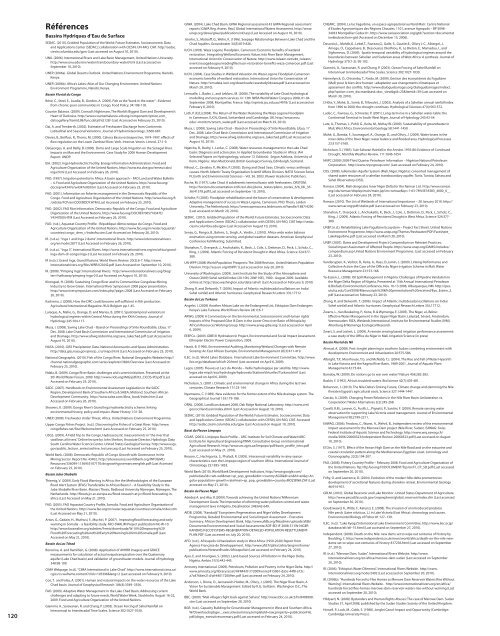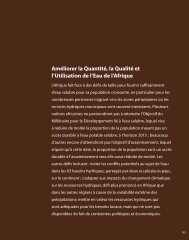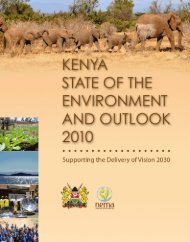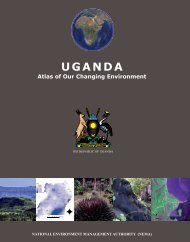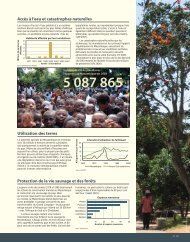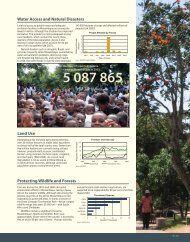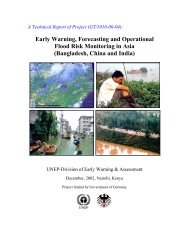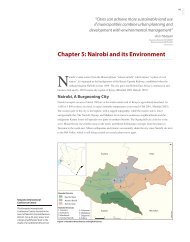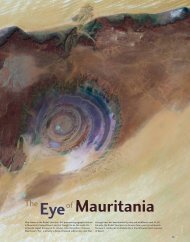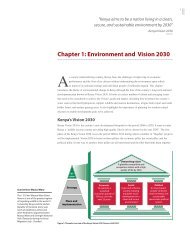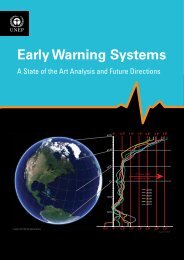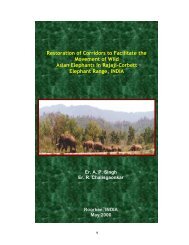Les systèmes hydriques se trouvent de l'échelle - UNEP/GRID-Sioux ...
Les systèmes hydriques se trouvent de l'échelle - UNEP/GRID-Sioux ...
Les systèmes hydriques se trouvent de l'échelle - UNEP/GRID-Sioux ...
Create successful ePaper yourself
Turn your PDF publications into a flip-book with our unique Google optimized e-Paper software.
120<br />
Références<br />
Bassins Hydriques d’Eau <strong>de</strong> Surface<br />
SEDAC. (2010). Grid<strong>de</strong>d Population of the World: Future Estimates. Socioeconomic Data<br />
and Applications Center (SEDAC); collaboration with CIESIN, UN-FAO, CIAT. http://<strong>se</strong>dac.<br />
ciesin.columbia.edu/gpw (Last acces<strong>se</strong>d on August 10, 2010).<br />
UNU. (2006). International Rivers and Lake Basin Management, United Nations University.<br />
http://www.unu.edu/env/water/transboundary-water.html (Last acces<strong>se</strong>d on<br />
September 10, 2010).<br />
<strong>UNEP</strong>. (2006a). Global De<strong>se</strong>rts Outlook. United Nations Environment Programme, Nairobi,<br />
Kenya.<br />
<strong>UNEP</strong>. (2006b). Africa’s Lakes: Atlas of Our Changing Environment. United Nations<br />
Environment Programme, Nairobi, Kenya.<br />
Bassin Fluvial du Congo<br />
Béné, C., Steel, E., Luadia, B., Gordon, A. (2009). Fish as the “bank in the water” –Evi<strong>de</strong>nce<br />
from chronic-poor communities in Congo. Food Policy. 34:108-118.<br />
Counter Balance. (2009). Conrad’s Nightmare, The World’s Biggest Dam and Development’s<br />
Heart of Darkness. http://www.counterbalance-eib.org/component/option,com_<br />
datsogallery/Itemid,98/func,<strong>de</strong>tail/id,128/ (Last Acces<strong>se</strong>d on February 25, 2010).<br />
Dai, A. and Trenberth. (2002). Estimates of Freshwater Discharge from Continents:<br />
Latitudinal and Seasonal Variations. Journal of Hydrometeorology. 3:660-687.<br />
Davies, B., Beilfuss, R., Thoms, M. (2000). Cahora Bassa restrospective, 1974-1997: eff ects of<br />
fl ow regulation on the Lower Zambezi River. Verh. Internat. Verein. Limnol. 27:1-9.<br />
DeGeorges, A. and Reilly, B. (2006). Dams and Large Scale Irrigation on the Senegal River.<br />
Impacts on Man and the Environment. Ca<strong>se</strong> Study for 2006 Human Development<br />
Report. UNDP.<br />
EIA. (2002). Inga Hydroelectric Facility. Energy Information Administration. Food and<br />
Agriculture Organization of the United Nations. http://www.eia.doe.gov/emeu/cabs/<br />
inga.html (Last Acces<strong>se</strong>d on February 26, 2010).<br />
FAO. (1997). Irrigation potential in Africa: A basin approach – FAO Land and Water Bulletin<br />
– 4. Food and Agriculture Organization of the United Nations. http://www.fao.org/<br />
docrep/w4347e/w4347e00.htm (Last Acces<strong>se</strong>d on February 25, 2010).<br />
FAO. (2001). Information on fi sheries management in the Democratic Republic of the<br />
Congo. Food and Agriculture Organization of the United Nations. http://www.fao.org/fi<br />
/oldsite/FCP/en/COD/BODY.HTM (Last Acces<strong>se</strong>d on February 25, 2010).<br />
FAO. (2002). FAO Rice Information. Democratic Republic of the Congo. Food and Agriculture<br />
Organization of the United Nations. http://www.fao.org/DOCREP/005/Y4347E/<br />
Y4347E00.HTM (Last Acces<strong>se</strong>d on February 26, 2010).<br />
FAO. (n.d.). Aquastat Country Profi le - République démocratique du Congo. Food and<br />
Agriculture Organization of the United Nations. http://www.fao.org/nr/water/aquastat/<br />
countries/congo_<strong>de</strong>m_r/in<strong>de</strong>xfra.stm (Last Acces<strong>se</strong>d on February 26, 2010).<br />
IR. (n.d.a.). “Inga 1 and Inga 2 dams”. International Rivers. http://www.internationalrivers.<br />
org/en/no<strong>de</strong>/2877 (Last Acces<strong>se</strong>d on February 26, 2010).<br />
IR. (n.d.a.). “Inga 3”. International Rivers. http://www.internationalrivers.org/en/africa/grandinga-dam-dr-congo/inga-3<br />
(Last Acces<strong>se</strong>d on February 26, 2010).<br />
IR (n.d.c). Grand Inga, Grand Illusions. World Rivers Review. 20(2):6-7. http://www.<br />
internationalrivers.org/fi les/WRR.V20.N2.pdf (Last Acces<strong>se</strong>d on September 10, 2010).<br />
IR. (2008). “Pimping Inga”. International Rivers. http://www.internationalrivers.org/blog/<br />
terri-hathaway/pimping-inga-0 (Last Acces<strong>se</strong>d on August 10, 2010).<br />
Kirongozi, H. (2008). Sustaining Congo River and its Communities: Congole<strong>se</strong> Mining<br />
Industry to Grow Green. International River Symposium 2008 paper pre<strong>se</strong>ntation.<br />
http://www.riversymposium.com/in<strong>de</strong>x.php?page=2008 (Last Acces<strong>se</strong>d on February<br />
26, 2010).<br />
Kashema, J. (2008). How the DRC could become <strong>se</strong>lf-suffi cient in fi sh production.<br />
Agricultural International Magazine /KUL-Belgium pp.1-45.<br />
Laraque, A., Mahe, G., Orange, D. and Marieu, B. (2001). Spatiotemporal variations in<br />
hydrological regimes within Central Africa during the XXth Century. Journal of<br />
Hydrology 245:104-117.<br />
Musa, I. (2008). Saving Lake Chad – Ba<strong>se</strong>d on Proceedings of Sirte Roundtable, Libya, 17<br />
Dec. 2008. Lake Chad Basin Commission and International Commission of Irrigation<br />
and Drainage. http://www.afrwg.icidonline.org/save_lakechad.pdf (Last Acces<strong>se</strong>d on<br />
August 10, 2010).<br />
NASA. (2010). GISS Precipitation Data. National Aeronautics and Space Administration.<br />
http://data.giss.nasa.gov/precip_cru/maps.html (Last Acces<strong>se</strong>d on February 25, 2010).<br />
National Geographic. (2010). Fish of the Congo River, National Geographic Website.http://<br />
channel.nationalgeographic.com/<strong>se</strong>ries/explorer/3826/Overview (Last Acces<strong>se</strong>d on<br />
February 25, 2010).<br />
Ndala, B. (2009). Congo River Basin: challenges and current initiatives. Pre<strong>se</strong>nted at the<br />
5th World Water Forum, 2009. http://www.riob.org/IMG/pdf/03_CICOS-PO.pdf (Last<br />
Acces<strong>se</strong>d on February 25, 2010).<br />
SADC. (2007). Handbook on Environmental As<strong>se</strong>ssment Legislation in the SADC<br />
Region. Development Bank of Southern Africa & SAIEA, Midrand. Southern African<br />
Development Community. http://www.saiea.com/dbsa_book/in<strong>de</strong>x.htm (Last<br />
Acces<strong>se</strong>d on February 26, 2010).<br />
Showers, K. (2009). Gongo River’s Grand Inga hydroelectricity scheme: linking<br />
environmental history, policy and impact. Water History 1:31-58.<br />
<strong>UNEP</strong>. (2008). Freshwater Un<strong>de</strong>r Threat, Africa. United Nations Environment Programme.<br />
Upper Congo Fishes Project. (n.d.). Discovering the Fishes of a Great River. http://www.<br />
congofi shes.net/Site/Welcome.html (Last Acces<strong>se</strong>d on February 25, 2010).<br />
USGS. (2009). A Field Trip to the Congo, Hydroacoustic measurements in “the river that<br />
swallows all rivers.” Online lecture by John Shelton, Associate Director, Hydrologic Data<br />
South Carolina Water Science Center. United States Geological Survey. http://www.usgs.<br />
gov/public_lecture_<strong>se</strong>ries/archive_lectures.asp (Last Acces<strong>se</strong>d on February 25, 2010).<br />
World Bank. (2008). Democratic Republic of Congo Growth with Governance In the<br />
Mining Sector. Report No. 43402. http://siteresources.worldbank.org/INTOGMC/<br />
Resources/336099-1156955107170/drcgrowthgovernanceenglish.pdf (Last Acces<strong>se</strong>d<br />
on February 25, 2010).<br />
Bassin Juba-Shabelle<br />
Thiemig, V. (2009). Early Flood Warning in Africa: Are the Methodologies of the European<br />
fl ood Alert System (EFAS) Transferable to African Basins? – A Feasibility Study in the<br />
Juba-Shabelle River Basin. Masters Thesis, Radboud University Nijmegen, Nijmegen, The<br />
Netherlands. http://fl oods.jrc.ec.europa.eu/fl ood-re<strong>se</strong>arch-at-jrc/fl ood-forecasting-inafrica<br />
(Last Acces<strong>se</strong>d on May 21, 2010).<br />
FAO. (2005). FAO Aquastat Country Profi le, Somalia. Food and Agriculture Organization of<br />
the United Nations. http://www.fao.org/nr/water/aquastat/countries/somalia/in<strong>de</strong>x.stm<br />
(Last Acces<strong>se</strong>d on May 21, 2010).<br />
Artan, G., Gadain, H., Muthusi, F., Muchiri, P. (2007). Improvingfl ood forecasting and early<br />
warning in Somalia – a feasibility study. FAO-SWALIM Project publicationi No W-10.<br />
http://www.faoswalim.org/subsites/frrmis/downloads/W-10%20Improving%20<br />
Flood%20Forecasting%20and%20Early%20Warning%20in%20Somalia.pdf (Last<br />
Acces<strong>se</strong>d on May 21, 2010).<br />
Bassin du Lac Tchad<br />
Boronina, A. and Ramillien, G. (2008). Application of AVHRR imagery and GRACE<br />
measurements for calculation of actual evapotranspiration over the Quaternary<br />
aquifer (Lake Chad basin) and validation of groundwater mo<strong>de</strong>ls. Journal of hydrology<br />
348:98-109.<br />
CIMA Webpage. (n.d.). “CIMA International in Lake Chad”. http://www.international.cima.ca/<br />
cgics/cs.waframe.content?click=105396&lang=2 (Last acces<strong>se</strong>d on February 9, 2010).<br />
Coe, T. and Foley, A. (2001). Human and natural impacts on the water resources of the Lake<br />
Chad basin. Journal of Geophysical Re<strong>se</strong>arch 106(4):3349–3356.<br />
FAO. (2009). Adaptive Water Management in the Lake Chad Basin, Addressing current<br />
challenges and adapting to future needs, World Water Week, Stockholm, August 16-22,<br />
2009. Food and Agriculture Organization of the United Nations.<br />
Giannini, A., Saravanan, R. and Chang, P. (2003). Ocean Forcing of Sahel Rainfall on<br />
Interannual to Inter<strong>de</strong>cadal Time Scales. Science 302:1027-1030.<br />
GIWA. (2004). Lake Chad Basin, GIWA Regional as<strong>se</strong>ssment 43 GIWA Regional as<strong>se</strong>ssment<br />
reports [GIWA Reg. As<strong>se</strong>ss. Rep.] Global International Waters As<strong>se</strong>ssment. http://www.<br />
unep.org/<strong>de</strong>wa/giwa/publications/r43.asp (Last Acces<strong>se</strong>d on August 10, 2010).<br />
Isiorho, S., Matisoff , G., Wehn, K. (1996). Seepage Relationships Between Lake Chad and the<br />
Chad Aquifers. Groundwater 34(5):819-826.<br />
IUCN. (2003). Waza Logone Floodplain, Cameroon: Economic benefi ts of wetland<br />
restoration. Integrating Wetland Economic Values into River Basin Management.<br />
International Union for Con<strong>se</strong>rvation of Nature. http://www.iwlearn.net/abt_iwlearn/<br />
events/ouagadougou/readingfi les/iucn-restoration-benefi ts-waza-cameroon.pdf (Last<br />
acces<strong>se</strong>d on February 9, 2010).<br />
IUCN. (2004). Ca<strong>se</strong> Studies in Wetland Valuation #4, Waza Logone Floodplain Cameroon:<br />
economic benefi ts of wetland restoration. International Union for Con<strong>se</strong>rvation of<br />
Nature. http://cmsdata.iucn.org/downloads/ca<strong>se</strong>study04waza.pdf (Last acces<strong>se</strong>d on<br />
March 29, 2010).<br />
Lemoalle, J., Ba<strong>de</strong>r, J., and Leblanc, M. (2008). The variability of Lake Chad: hydrological<br />
mo<strong>de</strong>lling and ecosystem <strong>se</strong>rvices. In: 13th IWRA World Water Congress 2008, 01-04<br />
September 2008, Montpellier, France. http://eprints.jcu.edu.au/4918/ (Last acces<strong>se</strong>d on<br />
February 8, 2010).<br />
Loth, P. (Ed.).(2004). The Return of the Water: Restoring the Waza Logone Floodplain<br />
in Cameroon. IUCN, Gland, Switzerland and Cambridge, UK. http://www.wou.<br />
edu/~moritzm/return_water.pdf (Last acces<strong>se</strong>d on March 29, 2010).<br />
Musa, I. (2008). Saving Lake Chad – Ba<strong>se</strong>d on Proceedings of Sirte Roundtable, Libya, 17<br />
Dec. 2008. Lake Chad Basin Commission and International Commission of Irrigation<br />
and Drainage. http://www.afrwg.icidonline.org/save_lakechad.pdf (Last Acces<strong>se</strong>d on<br />
August 10, 2010).<br />
Ngatcha, B., Budry, J., Leduc, C. (2008). Water resources management in the Lake Chad<br />
basin: Diagnosis and action plan. In Applied Groundwater Studies in Africa: IAH<br />
Selected Papers on Hydrogeology, volume 13 Editor(s): Segun A<strong>de</strong>lana, University of<br />
Ilorin, Nigéria; Alan MacDonald, British Geological Survey, Edinburgh, Scotland.<br />
Nihoul, C., Zavialov, P., Micklin, P. (2003). Dying and Dead Seas: Climatic versus anthropic<br />
cau<strong>se</strong>s. North Atlantic Treaty Organization Scientif Aff airs Division, NATO Science Series<br />
IV, Earth and Environmental Sciences – Vol. 36. 2003. Kluwer Aca<strong>de</strong>mic Publishers.<br />
Roche, M. (1977). Lake Chad: A sub<strong>de</strong><strong>se</strong>rtic terminal basin with freshwaters. ORSTOM.<br />
http://horizon.documentation.ird.fr/exl-doc/pleins_textes/pleins_textes_6/b_fdi_35-<br />
36/41578.pdf (Last acces<strong>se</strong>d on September 10, 2010).<br />
Scholte, P. (2005). Floodplain rehabilitation and the future of con<strong>se</strong>rvation & <strong>de</strong>velopment:<br />
Adaptive management of succes in Waza-Logone, Cameroon, PhD. Thesis, Lei<strong>de</strong>n<br />
University, The Netherlands. https://www.openaccess.lei<strong>de</strong>nuniv.nl/handle/1887/4290<br />
(Last acces<strong>se</strong>d on March 29, 2010).<br />
SEDAC. (2010). Grid<strong>de</strong>d Population of the World: Future Estimates. Socioeconomic Data<br />
and Applications Center (SEDAC); collaboration with CIESIN, UN-FAO, CIAT http://<strong>se</strong>dac.<br />
ciesin.columbia.edu/gpw (Last Acces<strong>se</strong>d on August 10, 2010).<br />
Senay, G., Pengra, B., Bohms, S., Singh, A., Verdin, J. (2010). Africa-wi<strong>de</strong> water balance<br />
estimation using remote <strong>se</strong>nsing and global weather data<strong>se</strong>ts. American Geophysical<br />
Conference Fall Meeting. Submitted.<br />
Shanahan, T., Overpeck, J., Anchukaitis, K., Beck, J., Cole, J., Dettman, D., Peck, J., Scholz, C.,<br />
King, J. (2009). Atlantic Forcing of Persistent Drought in West Africa. Science 324:377-<br />
380.<br />
UN-WPP (2008) World Population Prospects: The 2008 Revision, United Nations Population<br />
Division. http://esa.un.org/UNPP/ (Last acces<strong>se</strong>d on July 20, 2010).<br />
University of Washington. (2009). Joint Institute for the Study of the Atmosphere and<br />
Ocean (2009) Sahel rainfall in<strong>de</strong>x (20-10N, 20W-10E), 1900 - August 2009. Available<br />
online at: http://jisao.washington.edu/data/sahel/ (Last Acces<strong>se</strong>d on February 9, 2010)<br />
Zhang, R. and Delworth, T. (2006). Impact of Atlantic multi<strong>de</strong>cadal oscillations on India/<br />
Sahel rainfall and Atlantic hurricanes. Geophysical Re<strong>se</strong>arch Letters 33:L17712<br />
Bassin du Lac Turkana<br />
Angelei, I. (2009) Another African Lake on the Endangered List, Ethiopian Dam Endangers<br />
Kenya’s Lake Turkana. World Rivers Review 24(1):6-7<br />
ARWG. (2009) A Commentary on the Environmental, Socioeconomic and Human rights<br />
Impacts of the Propo<strong>se</strong>d Gibe III Dam in the Lower Omo river Basin of Ethiopia by<br />
African Resources Working Group. http://www.arwg-gibe.org/ (Last acces<strong>se</strong>d on April<br />
6, 2009).<br />
EEEPCo. (2009). GIBE III Hydroelectric Project, Environmental and Social Impact As<strong>se</strong>ssment.<br />
Ethiopian Electric Power Corporation, 2009.<br />
Haack, B. (1996). Environmental Auditing, Monitoring Wetland Changes with Remote<br />
Sensing: An East African Example. Environmental Management 20(3):411-419.<br />
ILEC. (n.d.). World Lakes Databa<strong>se</strong>. International Lake Environment Committee. http://www.<br />
ilec.or.jp/databa<strong>se</strong>/afr/afr-20.html (Last acces<strong>se</strong>d on April 6, 2009).<br />
Legos. (2005). Fleuves et Lacs du Mon<strong>de</strong> – Veille hydrologique par satellite. http://www.<br />
legos.obs-mip.fr/soa/hydrologie/hydroweb/StationsVirtuelles/Turkana.html (Last<br />
acces<strong>se</strong>d on April 6, 2009).<br />
Nicholson, S. (2001). Climatic and environmental change in Africa during the last two<br />
centuries. Climate Re<strong>se</strong>arch 17:123-144.<br />
Nyamweru, C. (1989). New evi<strong>de</strong>nce for the former extent of the Nile drainage system. The<br />
Geographical Journal 155:179-188.<br />
ORNL. (2008). LandScan data<strong>se</strong>t 2008, Oak Ridge National Laboratory. http://www.ornl.<br />
gov/sci/landscan/in<strong>de</strong>x.shtml (Last Acces<strong>se</strong>d on August 10, 2010).<br />
SEDAC. (2010). Grid<strong>de</strong>d Population of the World: Future Estimates. Socioeconomic Data<br />
and Applications Center (SEDAC); collaboration with CIESIN, UN-FAO, CIAT. Acces<strong>se</strong>d<br />
http://<strong>se</strong>dac.ciesin.columbia.edu/gpw (Last Acces<strong>se</strong>d on August 10, 2010).<br />
Bassi du Fleuve Limpopo<br />
CGIAR. (2003). Limipopo Basin Profi le – ARC-Institute for Soil Climate and Water/ARC-<br />
Institute for Agricultural Engineering/IWMI. Consultative Group on International<br />
Agricultural Re<strong>se</strong>arch. http://www.arc.agric.za/limpopo/pdf/basin_profi le_intro.pdf<br />
(Last acces<strong>se</strong>d on May 21, 2010).<br />
Reason, C., Hachigonta, S., Phaladi, R. (2005). Interannual variability in rainy <strong>se</strong>ason<br />
characteristics over the Limpopo region of southern Africa. International Journal of<br />
Climatology 25:1835-1853.<br />
World Bank (2010). World Bank Development Indicators. http://www.google.com/<br />
publicdata?ds=wb-wdi&met=sp_pop_grow&idim=country:AGO&dl=en&hl=en&q=An<br />
gola+population+growth+rate#met=sp_pop_grow&idim=country:MOZ:BWA:ZAF (Last<br />
acces<strong>se</strong>d on May 21, 2010).<br />
Bassin du Fleuve Niger<br />
A<strong>de</strong><strong>de</strong>ji A. and Ako, R.(2009). Towards achieving the United Nations’ Millennium<br />
Development Goals: The imperative of reforming water pollution control and waste<br />
management laws in Nigéria. Desalination 248:642-649.<br />
AfDB. (2008). “Kandadji” Ecosystems Regeneration and Niger Valley Development<br />
Programme, Detailed Environmental and Social Impact As<strong>se</strong>ssment – Executive<br />
Summary. African Development Bank. http://www.afdb.org/fi leadmin/uploads/afdb/<br />
Documents/Environmental-and-Social-As<strong>se</strong>ssments/ADF-BD-IF-2008-51-EN-NIGER-<br />
KANDADJI-ECOSYSTEMS-REGENERATION-DETAILED-POPULATION-RESETTLEMENT-<br />
PLAN.PDF (Last acces<strong>se</strong>d on July 20, 2010).<br />
AFD. (n.d.). Africapolis: Urbanization study in West Africa (1950-2020) Report from<br />
Agence Françai<strong>se</strong> <strong>de</strong> Développement. http://www.afd.fr/jahia/Jahia/lang/en/home/<br />
publications/Note<strong>se</strong>tEtu<strong>de</strong>s/Africapolis# (Last acces<strong>se</strong>d on February 24, 2010).<br />
Ajao, E. and Anurigwo, S. (2002). Land-ba<strong>se</strong>d Sources of Pollution in the Niger Delta,<br />
Nigéria. Ambio 31(5):442-445.<br />
Amnesty International. (2009). Petroleum, Pollution and Poverty in the Niger Delta. http://<br />
www.amnesty.org/library/as<strong>se</strong>t/AFR44/017/2009/en/e2415061-da5c-44f8-a73ca7a4766ee21d/afr440172009en.pdf<br />
(Last acces<strong>se</strong>d on February 24, 2010).<br />
An<strong>de</strong>rson, I., Dione, O., Jaro<strong>se</strong>wich-Hol<strong>de</strong>r, M., Olivry, J. (2005). The Niger River Basin, A<br />
Vision for Sustainable Management. Edited by K.G. Golitzen. Washington D.C.; The<br />
World Bank.<br />
BBC. (2009). “Mali villagers fi ght back against Sahara”. http://news.bbc.co.uk/2/hi/8408568.<br />
stm (Last acces<strong>se</strong>d on September 20, 2010)<br />
BGR. (n.d.). Capacity Building for Groundwater Management in West and Southern Africa.<br />
W/Downloads/pbgw__executivesummary,templateId=raw,property=publicationFile.<br />
pdf/pbgw_executivesummary.pdf (Last acces<strong>se</strong>d on February 24, 2010).<br />
CNEARC. (2004). Le lac Faguibine, un espace agropastoral au Nord Mali : Centre National<br />
d’Etu<strong>de</strong>s Agronomiques <strong>de</strong>s Régions Chau<strong>de</strong>s, 1101, avenue Agropolis – BP 5098 -<br />
34033 Montpellier Ce<strong>de</strong>x 01. http://www.cariassociation.org/gtd/?<strong>se</strong>ction=documentat<br />
ion&sub<strong>se</strong>ction=gtd (Acces<strong>se</strong>d on December 15, 2006).<br />
Descroix,L., Mahéb,G., Lebel,T., Favreau,G., Galle, S., Gautier,E., Olivry J-C., Albergel, J.,<br />
Amogu, O., Cappelaere, B., Dessouassi, Diedhiou, R., Le Breton, E., Mamadou, I., and<br />
Sighomnou, D. (2009). Spatio-temporal variability of hydrological regimes around the<br />
boundaries between Sahelian and Sudanian areas of West Africa: A synthesis. Journal of<br />
Hydrology 375(1-2): 90-102.<br />
Giannini, A., Saravanan, R. and Chang, P. (2003). Ocean Forcing of Sahel Rainfall on<br />
Interannual to Inter<strong>de</strong>cadal Time Scales. Science 302:1027-1030.<br />
Hamerlynck, O., Chiramba, T., Pardo, M. (2009). Gestion <strong>de</strong>s éco<strong>systèmes</strong> du Faguibine<br />
(Mali) pour le bien-être humain : adaptation aux changements climatiques et<br />
apai<strong>se</strong>ment <strong>de</strong>s confl its. http://www.dialoguebarrages.org/dialoguebarrages/in<strong>de</strong>x2.<br />
php?option=com_docman&task=doc_view&gid=25&Itemid=39 (Last acces<strong>se</strong>d on<br />
March 30, 2010).<br />
L’Hôte, Y., Mahé, G., Somé, B., Triboulet, J. (2002). Analysis of a Sahelian annual rainfall in<strong>de</strong>x<br />
from 1896 to 2000; the drought continues. Hydrological Sciences 47(4):563-572.<br />
Lu<strong>de</strong>c, C., Favreau, G., Schroeter, P. (2001). Long-term ri<strong>se</strong> in a Sahelian water-table: the<br />
Continental Terminal in South-West Niger. Journal of Hydrology 243:43-54.<br />
Lutz, A., Thomas, J., Pohll, G., Keita, M., McKay W. (2009). Sustainability of groundwater in<br />
Mali, West Africa. Environmental Geology 58:1441-1450<br />
Mahé, G., Bamba, F., Soumaguel, A., Orange, D., and Olivry, J. (2009). Water los<strong>se</strong>s in the<br />
inner <strong>de</strong>lta of the River Niger: water balance and fl oo<strong>de</strong>d area. Hydrological Proces<strong>se</strong>s<br />
23:3157-3160.<br />
Nicholson, S. (1983). Sub-Saharan Rainfall in the Années 1976-80: Evi<strong>de</strong>nce of Continued<br />
Drought. Monthly Weather Review. 111:1646-1654<br />
NNPC (2009) 2009 Third Quarter Petroleum Information – Nigérian National Petroleum<br />
Corporation. http://www.nnpcgroup.com/ (Last acces<strong>se</strong>d on February 24, 2010).<br />
OSS. (2008). Iulleme<strong>de</strong>n Aquifer System (Mali, Niger, Nigéria): concerted management of<br />
shared water resources of a sahelian transboundary aquifer. Tunis, Tunisia; Sahara and<br />
Sahel Ob<strong>se</strong>rvatory (OSS).<br />
Ramsar. (2004). Mali <strong>de</strong>signates Inner Niger Delta for the Ramsar List. http://www.ramsar.<br />
org/cda/ramsar/display/main/main.jsp?zn=ramsar&cp=1-63-78%5E18383_4000_0__<br />
(Last acces<strong>se</strong>d on February 24, 2010).<br />
Ramsar. (2010). The List of Wetlands of International Importance – 28 January 2010. http://<br />
www.ramsar.org/pdf/sitelist.pdf (Last acces<strong>se</strong>d on February 23, 2010).<br />
Shanahan, T., Overpeck, J., Anchukaitis, K., Beck, J., Cole, J., Dettman, D., Peck, J., Scholz, C.,<br />
King, J. (2009). Atlantic Forcing of Persistent Drought in West Africa. Science 324:377-<br />
380.<br />
<strong>UNEP</strong>. (n.d.). Rehabilitating Lake Faguibine Ecosystem – Project Fact Sheet. United Nations<br />
Environment Programme. http://www.unep.org/Themes/freshwater/PDF/Factsheet_<br />
LakeFaguibine.pdf (Last acces<strong>se</strong>d on March 30, 2010).<br />
<strong>UNEP</strong>. (2007). Dams and Development Project Compendium on Relevant Practices,<br />
Social Impact As<strong>se</strong>ssment of Aff ected People. http://www.unep.org/DAMS/inclu<strong>de</strong>s/<br />
compendium.asp United Nations Environment Programme. (Last acces<strong>se</strong>d on February<br />
23, 2010).<br />
Van<strong>de</strong>rsypen, K., Verbist, B., Keita, A., Raes, D.,Jamin, J. (2009). Linking Performance and<br />
Collective Action-the Ca<strong>se</strong> of the Offi ce du Niger Irrigation Scheme in Mali. Water<br />
Resource Management 23:153-168.<br />
Yo-Essien, L. (2008). Oil Spill Management in Nigéria: Challenges of Pipeline Vandalism in<br />
the Niger Delta Region of Nigéria. Pre<strong>se</strong>nted at 15th Annual International Petroleum<br />
& Biofuels Environmental Conference, Nov. 10-13 2008, Albuquerque, NM. http://ipec.<br />
utulsa.edu/Conf2008/Manuscripts%20&%20pre<strong>se</strong>ntations%20received/Eyo_Essien_2.<br />
pdf (Last acces<strong>se</strong>d on February 23, 2010).<br />
Zhang, R. and Delworth, T. (2006). Impact of Atlantic multi<strong>de</strong>cadal oscillations on India/<br />
Sahel rainfall and Atlantic hurricanes. Geophysical Re<strong>se</strong>arch Letters 33:L17712.<br />
Zwarts, L., Van Beukering, P., Kone, B. & Wymenga, E. (2005). The Niger, a Lifeline:<br />
Eff ective Water Management in the Upper Niger Basin. Lelystad, Sévaré, Amsterdam,<br />
Veenwou<strong>de</strong>n: RIZA, Wetlands International, Institute for Environmental Studies (IVM),<br />
Altenburg & Wymenga Ecological Re<strong>se</strong>arch.<br />
Zwart, S. and Leclert, L. (2009). A remote <strong>se</strong>nsing ba<strong>se</strong>d irrigation performance as<strong>se</strong>ssment:<br />
a ca<strong>se</strong> study of the Offi ce du Niger in Mali. Irrigation Science (in press)<br />
Bassin Fluvial du Nil<br />
Ahmad, A. (2008). Post-Jonglei planning in southern Sudan: combining environment with<br />
<strong>de</strong>velopment. Environment and Urbanization 20:575-586.<br />
Albright, T.P., Moorhou<strong>se</strong>, T.G. and McNabb, T.J. (2004). The Ri<strong>se</strong> and Fall of Water Hyacinth<br />
in Lake Victoria and the Kagera River Basin, 1989-2001. Journal of Aquatic Plant<br />
Management 42:73-84.<br />
Barnaby, W. (2009). Do nations go to war over water? Nature 458:282-283.<br />
Baskin, Y. (1992). Africa’s troubled waters. BioScience 42(7):476-481.<br />
Bohannon, J. (2010). The Nile Delta’s Sinking Future, Climate change and damming the Nile<br />
threaten Egypts’s agricultural oasis. Science 327:1444-1447.<br />
Cascão, A. (2009). Changing Power Relations in the Nile River Basin: Unilateraism vs.<br />
Cooperation? Water Alternatives 2(2):245-268.<br />
Cavalli, R.M., Laneve, G., Fusilli, L., Pignatti, P., Santini, F. (2009). Remote <strong>se</strong>nsing water<br />
ob<strong>se</strong>rvation for supporting Lake Victoria weed management. Journal of Environmental<br />
Management 90:2199-2211.<br />
EAWAG. (2006). Teodoru, C., Wuest, A., Wehrli, B., In<strong>de</strong>pen<strong>de</strong>nt review of the environmental<br />
impact as<strong>se</strong>ssment for the Merowe Dam project (Nile River, Sudan). EAWAG: Swiss<br />
Fe<strong>de</strong>ral Institute of Aquatic Science and Technology. http://www.wrq.eawag.ch/<br />
media/2006/20060323/In<strong>de</strong>pen<strong>de</strong>nt-Review-20060323.pdf (Last acces<strong>se</strong>d on August<br />
10, 2010).<br />
El Din, S. (1977). Eff ect of the Aswan High Dam on the Nile fl ood and on the estuarine and<br />
coastal circulation pattern along the Mediterranean Egyptian coast. Limnology and<br />
Oceanography, 22(2):194-207.<br />
FAO. (2008). Fishery Country Profi le – February 2008. Food and Agriculture Organization of<br />
the United Nations. ftp://ftp.fao.org/FI/DOCUMENT/fcp/en/FI_CP_SD.pdf (Last acces<strong>se</strong>d<br />
on September 20, 2010).<br />
Frihy, O. and Lawrence, D. (2004). Evolution of the mo<strong>de</strong>rn Nile <strong>de</strong>lta promontories:<br />
<strong>de</strong>velopment of accretional features during shoreline retreat. Environmental Geology<br />
46:914-931.<br />
GRLM. (2010). Global Re<strong>se</strong>rvoir and Lake Monitor -United States Department of Agriculture.<br />
http://www.pecad.fas.usda.gov/cropexplorer/global_re<strong>se</strong>rvoir/in<strong>de</strong>x.cfm (Last acces<strong>se</strong>d<br />
on September 30, 2010).<br />
Goudswaard, K., Witte, F., Katunzi, E. (2008). The invasion of an introduced predator,<br />
Nile perch (Lates niloticus, L.) in Lake Victoria (East Africa): chronology and cau<strong>se</strong>s.<br />
Environmental Biology of Fishes 81:127–139.<br />
ILEC. (n.d.). “Lake Kyoga”.International Lake Environment Committee. http://www.ilec.or.jp/<br />
databa<strong>se</strong>/afr/afr-15.html (Last acces<strong>se</strong>d on September 27, 2010).<br />
In<strong>de</strong>pen<strong>de</strong>nt. (2008). Death on the Nile: new dams <strong>se</strong>t to wipe out centuries of history by<br />
Boulding, C. http://www.in<strong>de</strong>pen<strong>de</strong>nt.co.uk/news/world/africa/<strong>de</strong>ath-on-the-nile-newdams-<strong>se</strong>t-to-wipe-out-centuries-of-history-817236.html<br />
(Last acces<strong>se</strong>d on September<br />
27, 2010).<br />
IR. (n.d.). “Merowe Dam, Sudan”. International Rivers Website. http://www.<br />
internationalrivers.org/en/africa/merowe-dam-sudan (Last acces<strong>se</strong>d on September<br />
20, 2010).<br />
IR. (2006). “Ethiopia’s Water Dilemma”. International Rivers Website. http://www.<br />
internationalrivers.org/no<strong>de</strong>/2492 (Last acces<strong>se</strong>d on September 20, 2010).<br />
IR. (2006b). “Hundreds Forced to Flee Homes as Merowe Dam Re<strong>se</strong>rvoir Waters Ri<strong>se</strong> Without<br />
Warning”. International Rivers Website. http://www.internationalrivers.org/en/africa/<br />
hundreds-forced-fl ee-homes-merowe-dam-re<strong>se</strong>rvoir-waters-ri<strong>se</strong>-without-warning (Last<br />
acces<strong>se</strong>d on September 20, 2010).<br />
Hildyard, N. (2008). Bystan<strong>de</strong>rs and Human Rights Abu<strong>se</strong>s: The ca<strong>se</strong> of Merowe Dam. Sudan<br />
Studies 37, April 2008, published by the Sudan Studies Society of the United Kingdom.<br />
Howell, P., Lock, M., Cobb, S. (1988). Jonglei Canal: Impact and Opportunity (Cambridge:<br />
Cambridge University Press).


